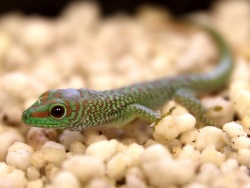Primorsky Aquarium receives offspring from geckos

The last week of March was especially fruitful for the Tropical Rain Forest exhibit. A Madagascar giant day gecko (Phelsuma madagascariensis grandis) male was born on March 27, and on March 29 its brother hatched.
A baby gecko comes out of the egg by breaking the shell with an egg tooth, a special structure on its premaxilla. A hatchling is about eight centimeters long from the tip of the snout to the tip of the tail. Interestingly, the diameter of Phelsuma eggs reaches only 1.5 cm, while mature adults may grow up to 30 cm in length.
Though the young of the Madagascar giant day gecko starts feeding only in two to three days, it is self-sufficient and independent immediately after hatching. The color pattern on its back and head is really glamorous. This pattern is individual for each specimen, similarly to fingerprints in humans.
“A Phelsuma female lays two eggs stuck together. Each clutch usually hatches into a female and a male,” says Artyom Gerasimenko, Principal Specialist of the Tropical Rain Forest Department. “An egg will produce a male or a female depending on the temperature of incubation. We can easily create the necessary difference in conditions by exposing one egg to light and having another one shielded from light. Owing to this natural mechanism, we can choose the geckos’ sex.”
Scientists and zoo keepers have long ago found out the exact temperature ranges: females are predominantly produced when incubated at 24 to 26 °C, whereas males are produced at 29 to 30 °C.
As males were at the moment more important for the gecko population in the Tropical Rain Forest exhibit, the eggs were incubated at the higher temperature.